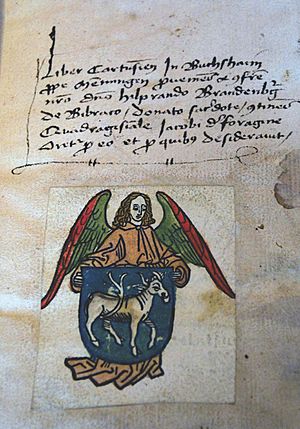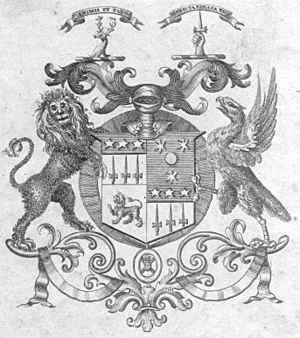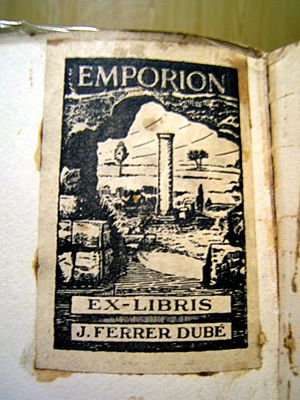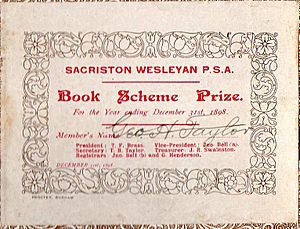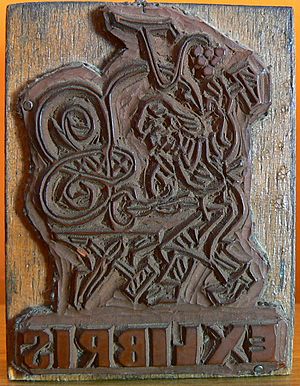Ex Libris (bookplate) facts for kids
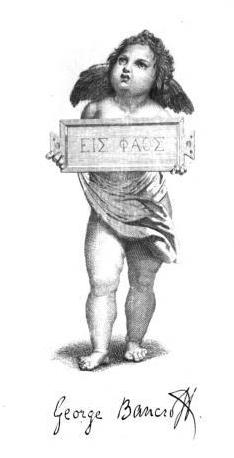
An Ex Libris (pronounced: eks LEE-bris) is a special printed or decorated label. It's also called a bookplate. People paste these labels inside their books, usually on the front page, to show who owns the book.
The words "Ex Libris" come from Latin, meaning "ex libris" or "from the books (or library) of". Bookplates often have a picture or design that tells you something about the owner. This could be a coat-of-arms, a special symbol, a motto, or a unique design made by an artist. They are important clues about where books came from.
Most bookplates are made using a method called engraving. An artist carves the design onto a metal plate. Then, ink is put on the plate and it's pressed onto paper. This creates the print that you can stick inside a book.
In the United States, bookplates became popular after the 1800s. They replaced older ways of marking books, like writing rhymes or even curses inside them!
Contents
History of Bookplates
Early Bookplates
The very first signs of people marking their books go way back to ancient Egypt, around 1391–1353 BCE.
However, bookplates as we know them today started in Europe during the Middle Ages. People began writing their names in books. The first printed bookplates appeared in Germany in the 1400s. One famous early example is a small, hand-colored picture of a shield. It was put into books given to a monastery by Brother Hildebrand Brandenburg around 1480.
After Germany, bookplates started appearing in other countries:
- France: The oldest known French bookplate is from 1529.
- Holland: The first one found is from 1597.
- Italy: An early example is from 1622.
- America: The first known American bookplate is from 1642. It was a simple printed label.
Famous artists like Albrecht Dürer in Germany even designed bookplates! Their designs influenced art for many years.
Bookplates in England
In England, bookplates became popular from the 1500s onwards. Early English bookplates were often simple, showing a family's coat-of-arms.
After the 1600s, bookplates became a common item in many libraries. Their designs changed over time, reflecting the popular art styles of each period. For example, some designs looked like carved oak, while others had fancy shell shapes.
Some bookplates were given out by schools or religious groups as prizes. These would have the winner's name written on them by hand.
By the 1800s, bookplates often featured a simple shield with a motto. But by the early 1900s, designs became much more varied and artistic.
Bookplates often showed different scenes:
- Library interiors: Pictures of a library room.
- Book-piles: Stacks of books.
- Portraits: Pictures of the book owner.
- Allegories: Symbolic pictures.
- Landscapes: Scenes of nature.
In these types of bookplates, the family crest or coat-of-arms was less important than the picture itself.
Bookplates as Art
In the past, making bookplates was often done by people who made stationery. But around the early 1900s, designing bookplates became seen as a form of art. Artists started creating many new and unique designs.
Instead of just showing a family crest, bookplates began to feature more symbolic or artistic pictures. Many artists used new printing methods to make beautiful and detailed designs more easily and cheaply. This helped make bookplates more popular.
Some artists continued to use traditional engraving methods, creating very detailed and beautiful bookplates. Famous engravers like C. W. Sherborn in England and E. D. French in America were known for their amazing work.
Collecting Bookplates
Collecting bookplates became popular around the 1860s. People collect them for different reasons:
- They show the decorative art styles of the past.
- They are personal items that belonged to famous people.
One of the first important books about collecting bookplates was A Guide to the Study of Book-Plates (Ex-Libris) by Lord de Tabley in 1880. This book helped people understand and classify different styles of bookplates.
Societies for bookplate collectors were started in England (1891), Germany, France, and the United States. These groups often published magazines about bookplates. The British Museum even has a huge collection of 35,000 bookplates!
Modern Bookplates
Since the 1950s, there's been new interest in collecting bookplates. Many collectors today see bookplates as tiny pieces of art. They often collect bookplates that are numbered and signed by artists. These are usually collected for display or trading, not always to be pasted into books.
Today, there are more than 50 national societies for bookplate collectors around the world. They are part of an international group called FISAE, which holds big meetings every two years.
-
Jacques Hnizdovsky's own bookplate, 1972
-
Bookplate of Edgar Rice Burroughs
-
Bookplate designed by artist Jacques Hnizdovsky for his wife Stephanie
See also
 In Spanish: Exlibris para niños
In Spanish: Exlibris para niños
- Book collecting
- Lithograph
- Library classification
- Printer's mark
- Title page
- Book frontispiece
- RFID
- Percy Neville Barnett, Australian bookplate collector
- Irena Sibley, contemporary Australian bookplate artist


